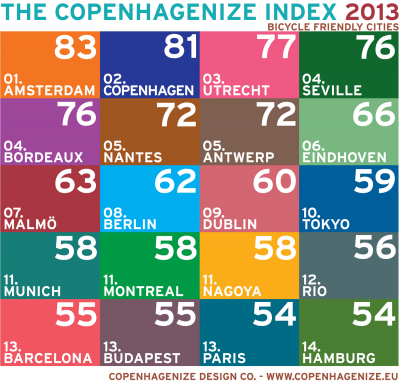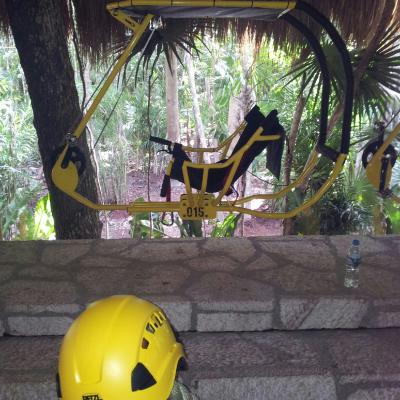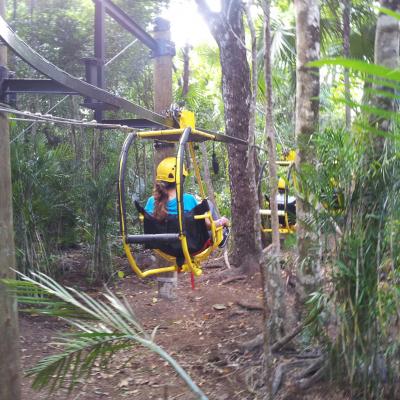The Best Biking Cities in the World
Researching for this post, I discovered the very helpful Copenhagenize Index 2013, which has chosen cities based on several factors contributing to the well being of the urban citizen. The last Index ranked 80 cities and this time around, they’ve rounded up 150 cities. They were graded in 13 categories and for each, they were given a score between 0 and 4. There are an extra 12 bonus points that could be won depending on how impressive the initiative for biking was, the politics implemented and the actual implementation.
I’ve included the graphic of the Index, which features the top 20 cities, some of which have tied for one place or another so in reality, you have the top 14 slots occupied by 20 cities from around the world. The Index itself was created originally for in-house use but was later considered a useful tool to share. Copenhagenize is a company that is dedicated to promoting bicycle culture in an urban setting, with respect to planning, traffic and communication. The Index’s about page refers to studies done in Denmark which talk about the relative gain or loss, depending on whether a city dweller rode a bike or not.

Listed below are the categories that these cities were graded in. (Note: this section is word for word what was on the site.)
The 13 Categories
Advocacy:
How is the city's (or region/country) advocacy NGO(s) regarded and what level of influence does it have? (Rated from no organised advocacy to strong advocacy with political influence.)
Bicycle Culture:
Has the bicycle reestablished itself as transport among regular citizens or only sub-cultures? (Rated from no bicycles on the urban landscape/only sporty cyclists to mainstream acceptance of the bicycle.)
Bicycle Facilities:
Are there readily accessible bike racks, ramps on stairs, space allocated on trains and buses and well-designed wayfinding, etc? (Rated from no bicycle facilities available to widespread and innovative facilities.)
Bicycle Infrastructure:
How does the city's bicycle infrastructure rate? (Rated from no infrastructure/cyclists relegated to using car lanes to high level of safe, separated cycle tracks.)
Bike Share Programme:
Does the city have a comprehensive and well-used bike-sharing programme? (Rated from no bike share programme to comprehensive, high-usage programme.)
Gender Split
What percentage of the city’s cyclists is male and female? (Rated from overwhelming male to an even gender split or more women than men cycling.)
Modal Share for Bicycles:
What percentage of modal share is made up by cyclists? (Rated from under 1% to over 25 %.)
Modal Share Increase since 2006:
What has the increase in modal share been since 2006 - the year that urban cycling started to kick off? (Rated from under 1% to 5%+.)
Perception of Safety:
Is the perception of safety of the cyclists in the city, reflected in helmet-wearing rates, positive or are cyclists riding scared due to helmet promotion and scare campaigns? (Rated from mandatory helmet laws with constant promotion of helmets to low helmet-usage rate.)
Politics:
What is the political climate regarding urban cycling? (Rated from the bicycle being non-existent on a political level to active and passionate political involvement.)
Social Acceptance:
How do drivers and the community at large regard urban cyclists? (Rated from no social acceptance to widespread social acceptance.)
Urban Planning:
How much emphasis do the city's planners place on bicycle infrastructure - and are they well-informed about international best practice? (Rated from car-centric urban planners to planners who think bicycle - and pedestrian - first.)
Traffic Calming:
What efforts have been made to lower speed limits - for example 30 km/h zones - and generally calm traffic in order to provide greater safety to pedestrians and cyclists? (Rated from none at all to extensive traffic-calming measures prioritising cyclists and pedestrians in the traffic hierarchy.)
------------------------
I also found some things worth mentioning, like the Trampe Bicycle Lift in Trondheim, Norway. This is basically a bike lift in the form of a foot pedal. You put one foot on it and it pushes you right up a hill.
There is also an interesting system called the Schweeb (German for “float” or “suspend”), which is a recumbent monorail bicycle. A race track is open in Rotorua, New Zealand. You can also find an open pod version of the Schweeb called the Zip Bike, an attraction in the Xel-Ha Eco Park, near Cancun, Mexico.

The Zip Bike at Xel-Ha Park in the Riviera Maya, Mexico

The Zip Bike in Action
At any rate, there are options. What would make a city better? If those with the power to do something would help a brother or sister out to make it safe for us bikers to get out there and do our thing, without getting hurt in the process.
And I wouldn't mind Schweebing to work. It looks like you can get some mad speed in one of those.
